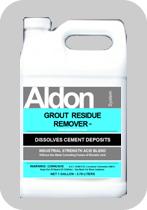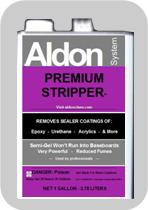Home | Surface Types | Problem Solving | Products | Prices & Ordering
The sections on this page discuss water leaking through interior and exterior constructions of walls, flooring, decking, etc.
Interior Walls: (See notes at bottom)
Subsurface Moisture Intrusion In Cellars and Crawlspace Walls. Applies to concrete block, stone, and "poured in place" concrete walls.
Option #1The best fix for this situation is fairly expensive to accomplish. It involves digging away dirt from the outside walls and applying a "subsurface" sealer. This is a heavy, tar like material available at building material stores.Option #2
There are products advertised as applied to the inside wall surfaces and stopping water entry. The results are mixed. The appearance is of a cement paste smeared on the surface.Option #3
All sealers must breathe water vapor. Therefore, Aldon sealers will not stop all moisture transmission under these conditions. However, they can slow it down enough to make a difference. As the walls will never be dry, they will never meet the application requirements of any sealers, except Aldon "Same Day Sealer".

Same Day is the only sealer that can be applied to a damp surface.
Whatever your choice for dealing with the water transmission, you will want to clean and prep the walls. To remove efflorescence (powder and crystals), stains, water marks, etc. the best and safest product is Aldon "Grout Residue Remover / Brick and Block Cleaner". Do not use muriatic acid.
Exterior Walls: (See notes at bottom) 
The term for a wall that holds back the earth (hillside bank) is a "Retaining Wall". These walls are highly prone to efflorescence (white powdery deposits) because the earth behind them is providing water and salts that will migrate to the surface of the wall. The options for dealing with this are the same as above for interior walls.
Notes:
Paint does nothing to help this situation. In fact, it makes the situation worse because the subsurface moisture pressure will make the paint bubble and peel over time. If the wall is already painted, you will need to remove the paint because it is in the way of any cleaning or treatment. The strongest stripper available is our "Premium Stripper". As it removes tough sealers like epoxy and urathane, it removes paint easily.

Painting again after sealing can be done, but must be tested over a few months with the sealer on a small test section. A good sealer's job is to repel things and that can create a situation where the paint will not bond well to a sealed surface. It is better to not paint at all if possible.
If you must paint over a sealer, test a petroleum based paint as they have better adhesion characteristics than water based paints.
Exterior Decking:
It is not uncommon to hear about a water proof deck that is allowing water entry to the walls or the area below. If you actually see water entry, it is probably from cracks in the deck flooring or a structural issue. Sealing is not the fix for this until other measures have been taken. Here are the things to consider:
- The deck may not be properly slanted down and away from the wall. This creates pooling against the wall. Options to fix this require a skilled carpenter.
- The "flashing" and caulking next to the wall may need to be reinstalled.
- Decking of tile work that leaks down to the ceiling of the room below is usually because of cracks in the grout joints and lack of a waterproof membrane underneath the tile work. See crack caulking elsewhere in this Problem Solving section and use a "paintable" caulk so that it will accept a sealer.